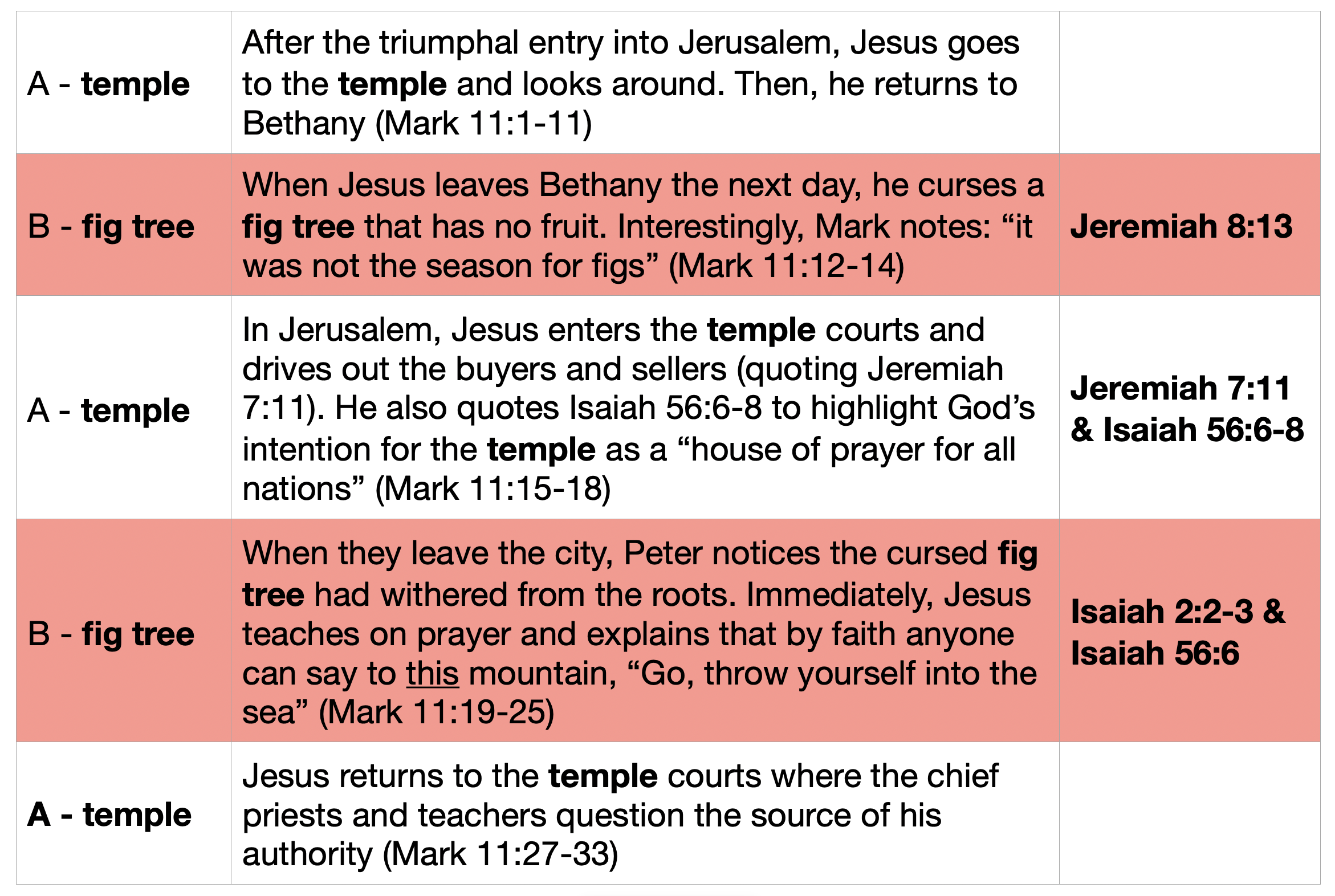Discover the Gospel of Mark in 3 WeeksSýnishorn

Jerusalem’s Temple is Fruitless (Mark 11:1-33)
In the morning, as they went along, they saw the fig tree withered from the roots. Mark 11:20 (NIV)
Context:
As we’ve studied this gospel, we’ve seen Mark intentionally place stories next to one another to encourage readers to interpret them in light of the other:
- On Day 8, the healing of the woman bleeding for 12 years (whom Jesus calls “Daughter”) appeared in an “interruption” of the healing of the synagogue leader’s 12-year-old daughter (Mark 5:21-43)
- On Day 9, the sending out and return of the 12 was “interrupted” by the story of John the Baptist’s death (Mark 6:7-31)
- On Day 13, we considered the significance of the placement of the 2-stage healing of the blind man immediately before stories illustrating the disciples’ partial understanding of who Jesus is and why he came (Mark 8:22-33)
- On Day 14, we noted that Mark both began and concluded the chapters on discipleship with the healing of blind men
In today’s reading, we will observe an extended version of this. Here, Mark goes back and forth (or “interchanges”) between references to the temple and references to fig trees. In order to understand his reasons, we need to consider the biblical context from the Prophetic literature:
- Jeremiah - The prophet Jeremiah denounced Israel’s priests and prophets, declaring, “There will be no figs on the tree, and their leaves will wither” (Jeremiah 8:13). The religious leaders had led the nation into sin rather than into the good fruit of faithfulness. In consequence, God had sent Jeremiah to denounce the temple as a “den of robbers” and predict its demise by Babylon in 586BC (Jeremiah 7:1-15).
- Isaiah - The prophet Isaiah described “the mountain of the Lord’s temple” as the highest of the mountains, with many nations coming to it to learn God’s ways (Isaiah 2:2-3); God also promises to gather foreigners and outcasts to his “holy mountain,” which will be called “a house of prayer for all nations” (Isaiah 56:6-8).
Observation
The chart below outlines the interchange in Mark 11, along with the connections to its Old Testament allusions.

Interpretation:
When Mark tells readers that Jesus cursed the fig tree for not bearing fruit even though “it was not the season for figs,” he clues them into the fact that the fig tree is a symbol for the temple. The biblical context from Jeremiah 7 and 8:13 supports this interpretation.
Here, Jesus (who is the Messianic King and God in flesh) witnesses the temple system’s fruitlessness. Buying and selling (probably unjustly) had become the focus, rather than prayer and mediating God’s blessing for all nations. Jesus’s curse of the fig tree is a prophetic picture of God’s judgment on the Jerusalem temple. Like Jeremiah before 586 BC, Jesus pronounces that God had abandoned his temple and it would fall. Jesus’s prophecy was fulfilled in AD70 when Rome destroyed the temple. It was never again rebuilt.
In the context of this interchange, Jesus teaches his disciples about prayer. He asserts that they have the authority to command “this mountain” to throw itself into the sea (Mark 11:22-25). At first, this teaching feels very out of place. However, the passages from Isaiah help us interpret “this mountain,” like the fig tree, as a symbol for the temple (see Isaiah 2:2-3 and 56:6). Jesus is again prophesying the physical temple’s destruction as a place of prayer. However, Jesus didn’t want his followers to be utterly dismayed by this. So, he teaches them that faith (and a lifestyle that reflects faith) is all that God looks for from people who turn to him in prayer. A special building isn’t necessary!
- What practical lessons on prayer is the church in Rome learning?
Application:
Spend some time reflecting on the fruit being produced in your life.
- First, note one way you are bearing the kind of fruit Jesus looks for. If you need a reminder of what fruit Jesus wants, check out Galatians 5:22-23.
- Second, note one area in which you are struggling to bear the fruit Jesus wants. Why is it a struggle for you in this area? Are you tempted to give up in the midst of the struggle? What is one thing that you could do today to move towards Jesus in the midst of this struggle?
Ritningin
About this Plan

This plan is intended as a guide to help you discover the message of Mark’s Gospel for yourself! Grab a notebook to jot down your thoughts as you are led through a process of: (1) observing the Gospel of Mark; (2) interpreting the original message to the church in Rome; and (3) applying the Gospel’s timeless truths to your life today.
More








